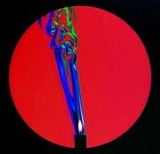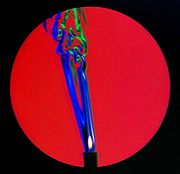
Schlieren
Encyclopedia

History
Schlieren were first observed by Robert HookeRobert Hooke
Robert Hooke FRS was an English natural philosopher, architect and polymath.His adult life comprised three distinct periods: as a scientific inquirer lacking money; achieving great wealth and standing through his reputation for hard work and scrupulous honesty following the great fire of 1666, but...
in 1665 using a large convex lens and two candles. One candle served as a light source. The warm air rising from the second candle provided the schliere.
The conventional schlieren system is credited mostly to German
Germany
Germany , officially the Federal Republic of Germany , is a federal parliamentary republic in Europe. The country consists of 16 states while the capital and largest city is Berlin. Germany covers an area of 357,021 km2 and has a largely temperate seasonal climate...
physicist August Toepler
August Toepler
August Joseph Ignaz Toepler was a German physicist known for his experiments in electrostatics. In 1864 he applied Foucault's knife-edge test for telescope mirrors to the analysis of fluid flow and the shock wave. He named this new method schlieren photography, for which he is justifiably famous...
. Toepler's original system was designed to detect schlieren in glass
Glass
Glass is an amorphous solid material. Glasses are typically brittle and optically transparent.The most familiar type of glass, used for centuries in windows and drinking vessels, is soda-lime glass, composed of about 75% silica plus Na2O, CaO, and several minor additives...
used to make lenses. In the conventional schlieren system , a point source
Point source
A point source is a localised, relatively small source of something.Point source may also refer to:*Point source , a localised source of pollution**Point source water pollution, water pollution with a localized source...
is used to illuminate the test section containing the schliere. An image of this light is formed using a converging lens (also called a schlieren lens). This image is located at the conjugate distance to the lens according to the thin lens
Thin lens
[Image:Lens1.svg|thumb|A lens can be considered a thin lens if d [Image:Lens1.svg|thumb|A lens can be considered a thin lens if d [Image:Lens1.svg|thumb|A lens can be considered a thin lens if d...
equation:

where
 is the focal length of the lens,
is the focal length of the lens,  is the distance from the object to the lens and
is the distance from the object to the lens and  is the distance from the image of the object to the lens. A knife edge at the point source-image location is positioned as to partially block some light from reaching the viewing screen. The illumination of the image is reduced uniformly. A second lens is used to image the test section to the viewing screen. The viewing screen is located a conjugate distance from the plane of the schliere.
is the distance from the image of the object to the lens. A knife edge at the point source-image location is positioned as to partially block some light from reaching the viewing screen. The illumination of the image is reduced uniformly. A second lens is used to image the test section to the viewing screen. The viewing screen is located a conjugate distance from the plane of the schliere.Schlieren flow visualization
Schlieren flow visualization is based on the deflection of light by a refractive indexRefractive index
In optics the refractive index or index of refraction of a substance or medium is a measure of the speed of light in that medium. It is expressed as a ratio of the speed of light in vacuum relative to that in the considered medium....
gradient The index gradient is directly related to flow density gradient. The deflected light is compared to undeflected light at a viewing screen. The undisturbed light is partially blocked by a knife edge. The light that is deflected toward or away from the knife edge produces a shadow pattern depending upon whether it was previously blocked or unblocked. This shadow pattern is a light-intensity representation of the expansions (low density regions) and compressions (high density regions) which characterize the flow.
See also
- Mach–Zehnder interferometer
- Schlieren photographySchlieren photographySchlieren photography is a visual process that is used to photograph the flow of fluids of varying density. Invented by the German physicist August Toepler in 1864 to study supersonic motion, it is widely used in aeronautical engineering to photograph the flow of air around objects...
- ShadowgraphShadowgraphShadowgraph is an optical method that reveals non-uniformities in transparent media like air, water, or glass. It is related to, but simpler than, the schlieren and schlieren photography methods that perform a similar function...
- Background-oriented schlieren technique
- Schlieren imagingSchlieren imagingSchlieren imaging is a method to visualize density variations in transparent media;in particular, the term "Schlieren imaging" refers to the implementation of schlieren photography to visualize the pressure field produced by ultrasonic transducer, generally in water or in other tissue-mimicking...
External links
- Non-intrusive optical diagnostic experiments for high-speed flow generator flowfield characterization
- Flow Visualization System for a Pulse Detonation Engine
- The Penn State University Gas Dynamics Lab
- Background Oriented schlieren for flow visualisation in hypersonic impulse facilities
- Visualisation of supersonic flows in shock tunnels using Background Oriented Schlieren (BOS) technique
- Video on Schlieren photographs
- Acoustic Field Characterization with SchlierenSystem

